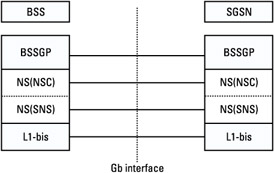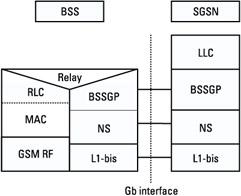Gb Interface
3.8 Gb Interface
The Gb interface connects the BSS and the SGSN. It allows for the exchange of signaling information and user data. Many users are multiplexed on the same physical resource. Resources are allocated to the user only during activity periods; after these periods, resources are immediately released and reallocated to other users. This is in contrast to the GSM A interface where one user has the sole use of a dedicated physical resource during the lifetime of a call.
No dedicated physical resources are required to be allocated for signaling purposes. Signaling and user data are sent in the same transmission plane. Figure 3.28 shows the transmission plane on the Gb interface.
 Figure 3.28: Transmission plane on Gb interface.
Figure 3.28: Transmission plane on Gb interface.
Transmission over the Gb interface is based on frame relay. Point-to-point (PTP) physical lines or an intermediate frame relay network can be used to connect the SGSN and the BSS.
3.8.1 NS Layer
The NS layer provides a frame-based, multiplexed link layer transport mechanism across the Gb interface that relies on the frame relay protocol.
The NS layer has been split into two sublayers, subnetwork service (SNS) and network service control (NSC) in order to make one sublayer independent of the intermediate transmission network. SNS is based on frame relay but NSC is independent of the transmission network. Later, it will be possible to change the transmission network (e.g., with an IP network) without changing the NSC sublayer.
Peer-to-peer communication across the Gb interface between the two remote NS entities in the BSS and the SGSN is performed over virtual connections. The NS layer is responsible for the management of the virtual connections between the BSS and the SGSN (verification of the availability of the virtual connections, initialization, and restoring of a virtual connection). It provides information on the status and the availability of the virtual connections to the BSSGP layer. It ensures the distribution of upper-layer PDUs between the different possible virtual connections (load-sharing function).
SNS provides access to the intermediate transmission network (i.e., the frame relay network). NSC is responsible for upper-layer data (BSSGP PDUs) transmission, load sharing, and virtual connection management.
3.8.2 BSSGP Principle
The BSSGP layer ensures the transmission of upper-layer data (LLC PDUs) from the BSS to the SGSN or from the SGSN to the BSS. It ensures the transmission of GMM signaling and NM signaling.
The peer-to-peer communication across the Gb interface between the two remote BSSGP entities in the BSS and the SGSN is performed over virtual connections. There is one virtual connection per cell at BSSGP layer. Each virtual connection can be supported by several layer 2 links between the SGSN and the BSS.
The BSSGP layer is responsible for the management of the virtual connections between the SGSN and the BSS (verification of the availability of the virtual connections, initialization and restoring of a virtual connection). The BSSGP layer also ensures the data flow control between the SGSN and the BSS.
There is a one-to-one relationship between the BSSGP in the SGSN and in the BSS. That means if one SGSN handles several BSSs, the SGSN must have one BSSGP protocol machine for each BSS. Figure 3.29 shows the position of the BSSGP layer within the BSS and the SGSN.

Figure 3.29: BSSGP position.






